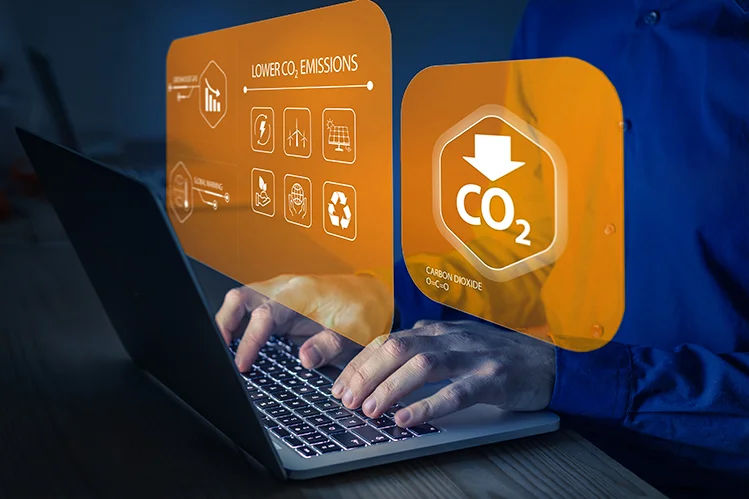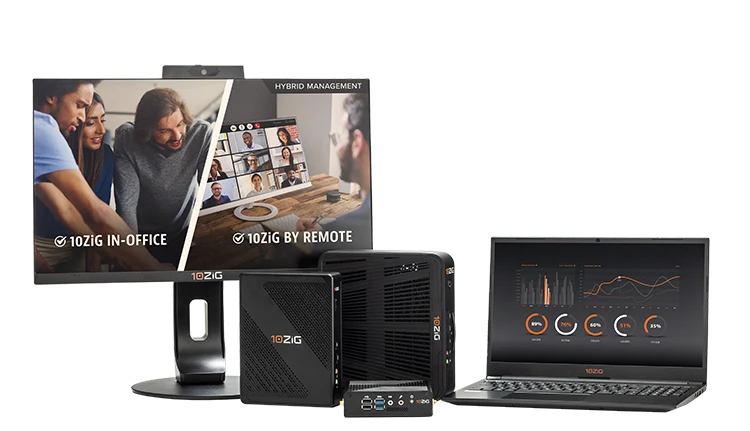#1- What is Thin Client Hardware?
A Thin Client is generally smaller and slimmer than a normal PC. It doesn’t contain the extent of hardware that a fat PC does, which allows it to fit everything needed right into its smaller form factor.
Most computers need plenty of CPU to run processes, greater amounts of RAM to perform multiple tasks at once, and a hard drive, or solid-state drive, to hold data. While Thin Clients do contain all of these elements, they are generally much smaller in capacity because most of the computer’s workload is NOT run on the machine itself. Instead, Thin Clients only need enough resources to boot up and connect to a centralized computer, such as a high-powered server in a data center. That computer then uses its resources to provide the Thin Client setup with a desktop experience, including any applications that the user wants to run.
You can think of it like hiring a moving company. While you’re probably going to share the load to some extent and carry some of your belongings to your new home yourself, the majority of the heavy lifting is going to be handled by movers.

How do I Compare Thin Client Hardware?
So, while you can find Thin Clients with various hardware features, it’s often not the most critical factor. This is a big departure from shopping for normal PCs when metrics like CPU speed and RAM capacity are life or death. Still, these factors can play a role, which is why 10ZiG offers products ranging from the 4600q Series for entry-level users to the 6100 Series for users with high-power demand.
There are other, equally important hardware considerations that differentiate these products. These include the number of USB ports, the number of and refresh rate of display ports/HDMI ports, and the existence of other features like a COM port, or DDR4 SO-DIMM slots, that enable adding more RAM down the road if needed.
What’s the Lifespan of a Thin Client?
Another main departure point between Thin Clients and normal PCs is lifespan. Regular PCs require more frequent updates as technology advances, and we ask them to handle bigger workloads. Since the main job of a Thin Client is connecting to VDI(Virtual Desktop Infrastructure) , we don’t ask it to evolve in the same way. Rather than upgrading the endpoint’s apps and software, apart from VDI clients and necessary OS upgrades, we can just upgrade the virtual desktops running on the centralized hosting infrastructure that our Thin Clients connect to.
Not only does this slash the cost of upgrading and give your endpoints a longer lifespan, but it also means that a single centralized infrastructure hardware upgrade instantly benefits every Thin Client that connects to it.
The average lifespan of a Thin Client can be up to eight to ten years. Compare that to the average three to five years you get out of a PC, and you’ll be more on the right track to start calculating the ROI in Thin Client technology.
What Impact do Thin Clients Have on my Electricity Bill and Carbon Footprint?
We can also derive an ROI from the fact that Thin Clients draw much less electricity. Since we don’t have to power all that hardware, Thin Clients only require a fraction of what it takes to run normal desktops. While the average PC consumes between 25 and 45 Kwh per month, a Thin Client only requires far less depending on the drive. The results are substantial energy savings and a reduced carbon footprint.
Taking this one step further, Thin Clients can also let us get more out of a past investment, while simultaneously reducing waste. Old PCs that are no longer powerful enough for modern desktop applications are often perfectly suited for repurposing as Thin Clients. 10ZiG RepurpOS Software transforms nearly any device to run a purpose-built operating system for VDI, DaaS, and Cloud. The fact that we can breathe new life into older models, highlights a critical point that you need to understand about Thin Clients – it can be about using software while planning for and purchasing more hardware.

#2 – What is Virtual Desktop Infrastructure Software (VDI)?
In a word, “VDI
#3 – Are Thin Clients Really Secure?
Thin Clients can help to protect against cyberthreats like ransomware and malware. Part of this is because of the process that we just outlined above – it’s much faster and easier to patch vulnerabilities, making it less likely that a machine slips through the cracks uncared for, etc.
Thin Clients can also help to reduce an organization’s overall security risk because they minimize the attack surface. Since most software does not run on individual computers, hackers can’t find as many exploits. On top of that, data is stored virtually or in the cloud instead of on local machines – i.e. virtual machines, if you will.
What this amounts to is that malicious actors would have to target a highly “fortified castle.

#4 – Do Thin Clients have Good Graphics?
Most Thin Clients are perfectly sufficient for most use cases. Cloud servers often give users access to high-quality GPUs. However, for graphically intense use cases that require low latency, like CAD software or video editing, it’s important to look for a Thin Client that has some degree of graphics processing on the endpoint.
There are also some differences between devices from a feature experience. The 10ZiG 6100 Series, for instance, can hook up to four monitors with 4K UHD at 60Hz, while the 4600q series supports two monitors with 4K UHD at 60Hz. Ultimately, this comes down to end user needs, requirements, preference, budget, and anything else you need to accomplish with your Thin Client VDI environment.
#5 – How Much Support Should I Expect from a Thin Client Provider?
While we would not speak for other Thin Client providers, we can stress the importance of choosing a partner who will support you in every step of your journey –from integration to ongoing maintenance, and beyond. That’s why providing exceptional customer service is 10ZiG’s top priority. Also, Thin & Zero Client Hardware and Software is all we do! Which makes us specialists in this field. Our concierge services include free software management, free demos, top-notch warranties, knowledgeable and available support close to you, pre-sales, and post-sales support, and more.
If you are not aware…
10ZiG is a leading Thin & Zero Client endpoint hardware and software provider for VDI, Cloud, DaaS, and SaaS. We provide leading Intel and AMD based, Dual and Quad Core Thin & Zero Clients for VMware, Citrix, Microsoft, and other environments. 10ZiG offers free, no-obligation demo devices, best-in-industry Technical Support teams based in the U.S. and Europe, and provides for FREE, Cloud-enabled “ 10ZiG Manager™
